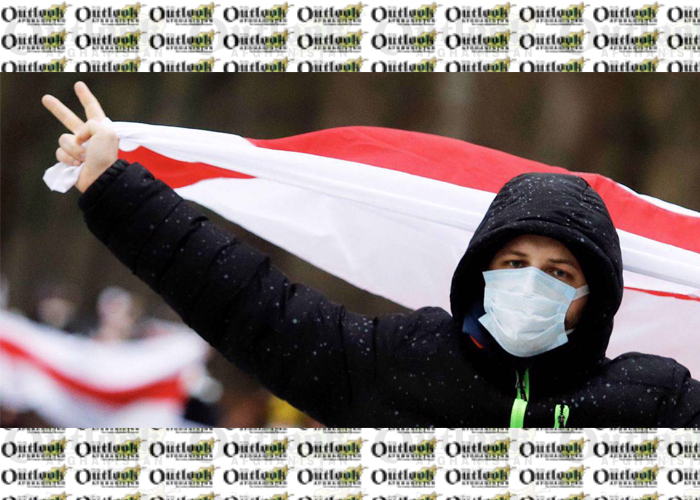Following his fraudulent re-election victory in August 2020, Belarusian President Aleksandr Lukashenko spent more than 100 days suppressing the massive peaceful protests that engulfed his country. But don’t read too much into the silence: far from being cowed, Belarusians are constantly adapting their tactics to wrong-foot the regime.
After the large-scale marches last fall in Minsk and other cities and towns, demonstrations became more localized and scattered, cropping up in residential areas around the country. Opposition hackers blocked government websites and hijacked state media’s online broadcasts, exposing the regime’s dirty laundry and the brutality meted out by its security services.
When journalists were prevented from reporting, citizen journalists started recording everything, demonstrating to the authorities that they could not hope to cover up official criminality. And, to this day, Belarusians are carrying out low-level sabotage, displaying the opposition flag and related symbols everywhere they can.
Lukashenko remains on the defensive. He has demanded that all anti-regime graffiti be removed and painted over as soon as it appears, creating a futile game of “Whack-a-Mole” for the authorities. He has even ordered that opposition flags embedded beneath the surface of frozen lakes be hacked out.
Ongoing opposition activities have imposed additional costs on a government that cannot afford to bear them. Today’s low oil and potassium fertilizer prices, Lukashenko’s closure of the borders, the exodus of young people (including tech and other highly skilled workers), work-to-rule resistance by factory workers, sanctions imposed by the European Union and the United States, and the COVID-19 pandemic have left the regime facing financial ruin. The European Bank for Reconstruction and Development and the European Investment Bank have suspended cooperation with the regime, and the International Monetary Fund has refused to offer it financing.
As a result, the authorities have been forced to spend some $1.5 billion of Belarus’s currency reserves to maintain the ruble’s exchange rate and cover the public debt. Aleś Alachnovič, an independent Belarusian economist, sees the regime heading for a slow-motion economic collapse. As of September 1, the central bank still had reserves of $7.5 billion, but only around 40% was denominated in foreign currencies.
With the ruble’s exchange rate at €0.32 ($0.39), the several billion rubles held by the finance ministry should be enough to keep the country relatively stable for several months. But after that, the financial rot will accelerate and become much more visible. And that, in turn, could trigger another wave of protests. As Alachnovič points out, the budget deficit for 2020 may have hit $2 billion, and likely will reach that level again in 2021. Lukashenko will have to come up with not just $4 billion to cover debt servicing, but also another $2 billion to cover the trade deficit.
To survive the winter, Lukashenko will need massive financial support from Russia. But, knowing that the regime cannot repay the debt, the Kremlin is likely to withhold or attach stringent conditions to its support. In exchange for hard currency, the Kremlin will demand a weaker Belarusian presidency and economic access for Russian oligarchs and state-owned enterprises. Lukashenko cannot hope to deliver on these demands while also remaining in power.
It is no secret that Russian President Vladimir Putin and Lukashenko despise each other. For years, Lukashenko regularly cheated the Kremlin by not upholding his side of various “oil-for-sovereignty” agreements (preferring “oil for kisses” instead). This history explains why Russia has not intervened directly to quell the protests. The Kremlin could easily stomach Lukashenko’s downfall, especially if he were replaced by a Russia-friendly successor.
To that end, The Insider, a Moscow-based independent newspaper, reports that the Kremlin is already forming a new pro-Russian party in Belarus. With the goal of including Belarusian media figures, ruling elites, and government officials among its members, the “People’s Law” party will stand ready to come out against Lukashenko (and in favor of deeper integration with Russia).
The People’s Law project is being headed by Russian General Vladimir Chernov, who has led the Kremlin’s previous efforts to thwart “color revolutions” in the ex-Soviet world. Chernov is now working to create a network of up to 1,200 potential candidates from various opposition parties. One plank in the new party’s platform is a call for privatization, which would entail selling the largest Belarusian enterprises to Russian oligarchs or state-owned giants such as Gazprom.
Chernov has carried out similar Kremlin initiatives in Moldova, Georgia, and Armenia, where Russia “allowed” sympathetic factions of the opposition to overthrow undemocratic governments. Belarus is incomparably more important to the Kremlin than these other countries; but the situation is delicate. Given its experience in Ukraine, Russia knows that using force could backfire by fostering a sense of shared identity and solidarity in Belarus.
Of course, that has already happened, with Belarusians preparing to take to the streets again in the spring. After months of learning from experience and building up their strength, they will be a formidable adversary for Lukashenko’s exhausted security services. In fact, there is still a chance that the independent opposition movement will both defeat the dictator and avoid ending up under Russia’s thumb.
It is thus a mistake to conclude that just because 200,000 people are no longer demonstrating in Minsk every week, the Belarusian people have surrendered. The protests have simply moved and changed form for the winter.
The most important factor now is the security services that are protecting Lukashenko. BYPOL, an organization of security employees who have left or are helping the opposition while still working for the regime, is publishing more and more materials documenting a breakdown of discipline and morale within the OMON (riot police), state-aligned militias, and the special forces.
More and more siloviki (state elites) are leaving, and those who stay no longer do so out of conviction. The regime, it seems, is dying from within.
Home » Opinion » Has Lukashenko Won?
Has Lukashenko Won?
| Sławomir Sierakowski

